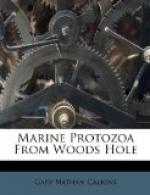a. Peristome drawn out into Family
Spirochonidae
funnel-like process; parasitic
b. Adoral zone and circlet of cilia Family
Lichnophoridae
at opposite end. Adoral zone
(one genus, *_Lichnophora_)
left-wound. Parasitic.
c. Adoral zone a left-wound spiral.
Family Vorticellidae
Attached or unattached forms.
* Presence at Woods Hole indicated by asterisk.
Genus LICHNOPHORA Claparede ’67.
(Gruber ’84; Fabre-Domergue ’88; Buetschli
’88; Wallengren ’94;
Stevens 1901.)
Small or medium-sized colorless animals, extremely elastic and flexible. The anterior part, bearing the adoral zone, is round or oval in ventral view, and has a flat ventral and a highly arched dorsal surface. The posterior end of the animal is reduced to a stalk-like structure which is broadened at the extremity to form a sucking disk. The surface of this disk and the surface of the peristome may be brought into the same plane by the characteristic bending of the stalk portion. A ciliated girdle is placed at the edge of the sucking disk. A well-developed adoral zone incloses the peristome; it begins at the mouth on the left side and includes nearly all of the peristome in its left-wound spiral, the extremity approaching closely the end near the mouth. The macronucleus is a long-beaded structure, or it may be in several parts connected by strands (Gruber). The contractile vacuole is on the left side in the region of the mouth. Salt water.
Lichnophora macfarlandi Stevens. Fig. 58.
The body is elongate; oral disk variable in form, attachment disk clearly defined and constant. The stalk is very contractile and elastic, constantly changing in shape. When detached from the host the animal moves with a very irregular and indefinite motion. When attached it moves freely over the surface on its pedal disk. The latter is bordered by four membranes composed of cilia. A distinct axial fiber extends from the pedal disc to the peristome and gives off a number of branches. This fiber is analogous to the myonemes in Vorticella. An indistinct longitudinal furrow can be made out occasionally. The nucleus is in 5 or 6 separate pieces, of which 1 is found in the pedal disk and 1 or 2 in the neck.
On the egg capsules of Crepidula plana; also reported upon annelids at Woods Hole.
Length 60 mu from disk to extremity of the peristomial disk.
[Illustration: Fig. 58.—Lichnophora macfarlandi.]
This form does not agree in all respects with Stevens’s species, but the agreement is so close in other respects that I believe it can be safely identified as L. macfarlandi. The mode of life is different, and the macronucleus is different, there being from 25 to 30 fragments in Stevens’s form and only 5 or 6 in the present one. There is, however, the same evidence of chain formation in both of them. The length of the oral cilia in Stevens’s form is 18 mu in fixed and 30 mu in living forms. In the Woods Hole form the cilia are not more than half that length.




